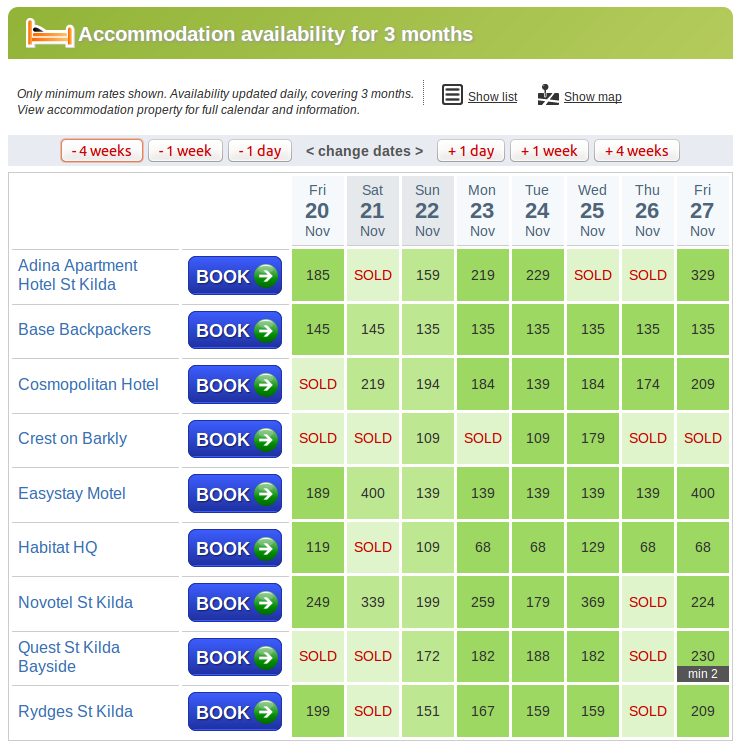Wotif was established during 2000 in Australia as an online hotel booking service. It was bought by United States travel giant Expedia during late 2014.
Up until recently, what set Wotif apart from other online booking and comparison service was its grid or matrix of hotel prices and availability. Many other competing services required a traveller to provide their exact check-in date and duration of stay before they were presented with a matching list of hotel availability options. In striking contrast, Wotif simply presented an availability and pricing grid across all hotels so travellers could see at a glance their options. This particularly suited people who were flexible with their travel arrangements or who were hunting for the best deal. See the example below.
At the time, Wotif’s executive general manager underlined the difference between Wotif and other online booking services by these quotes in regards to its availability and pricing grid / matrix:
- “It’s one of those things we know has a big fan base…and continues to provide an easy way to compare rates for price sensitive travellers who have flexibility about when they want to travel.”
- “The grid layout is now also somewhat unique. On most sites, customers would have a hard time knowing if the next or previous day or week offered a better deal.”
In early 2015, Wotif changed their availability display style to match the theme of Expedia which meant travellers needed to specify specific dates and stay durations before they could search for availability. This caused the following issues:
- If someone was wanting to find availability or the best rates for a weekend stay, but had flexibility about which weekend, it would require them to conduct a separate search for each weekend and write each one down to compare. With the Wotif availability grid, a traveller could see instantly the availability across a range of hotels, and simply flick the calendar forward to get to the next weekend
- Someone with flexibility in regards to the duration of their stay would now need to conduct separate searches with different durations to see the availability and tariffs. Whereas with Wotif’s former matrix, travellers could see, at a glance, whether they could change the length of their stay and which hotels could accommodate them.
Many people have some degree of flexibility when it comes to their travel plans, particularly if it is for leisure purposes, so having to go through a time consuming process of trying various combinations of check-in dates and stay durations can seem very cumbersome with Wotif’s new Expedia interface than simply casting one’s eye over a availability grid which covers a range of accommodation properties, dates and prices.
Like many others, we here at Travel Victoria missed the Wotif availability grid. So we did something about it!
As an official Wotif affiliate partner, we had the opportunity to request access to the Wotif API through Expedia, which would allow us to extract availability and pricing from their live database without having to go through the web interface. This meant we could build a customised table of availability across a range of hotels. Thus we were able to recreate a simplified version of the much loved Wotif matrix, as shown below for our St Kilda accommodation list:
We do have a few limitations:
- It is not a real-time availability matrix as it actually takes a few hours to build up the matrix of availability for the several hundred hotels in Victoria we have chosen to feature in the grid. At the moment, it is automatically updated once a day, with this process concluding in the late afternoon.
- It only covers 3 months. People looking for accommodation more than 3 months into the future will still need to do a traditional (and cumbersome) search by date.
- It only shows availability for stays which have a minimum duration of 3 nights or less, as testing for longer minimum stays would slow down the database update significantly.
- It only shows the base or minimum rate for the cheapest room. To get the rates for all room types and numbers of guests, people will still need to go through the regular Expedia style interface. Wotif actually had a second level grid which would open up if you restricted your search to a specific hotel, thus showing all room types and rates.
So the Wotif grid is back, alive and well, although in a much simpler form, now on the Travel Victoria website!


Leave a Reply